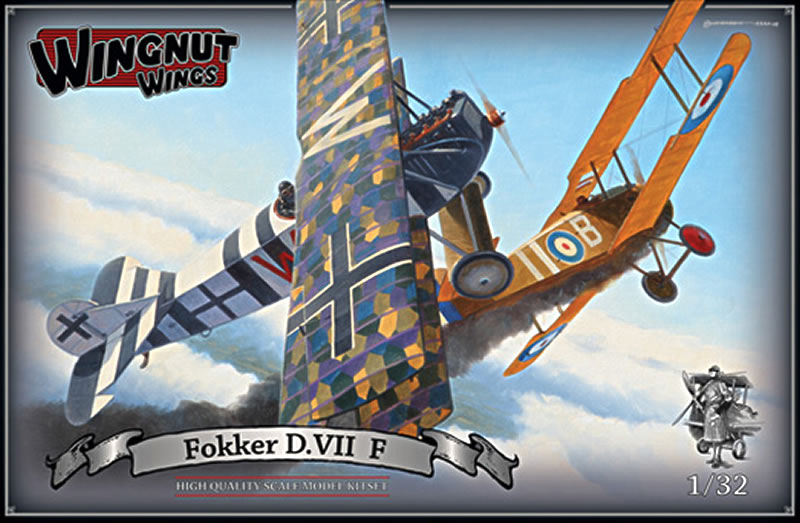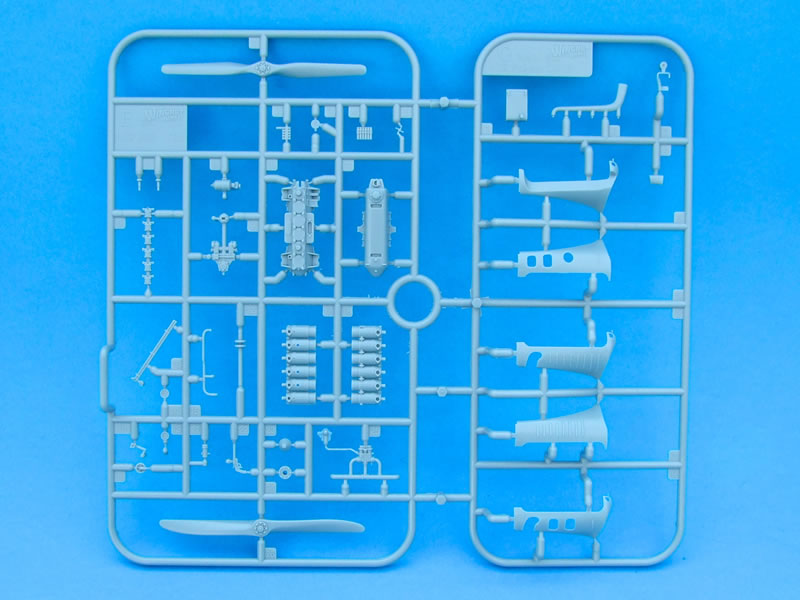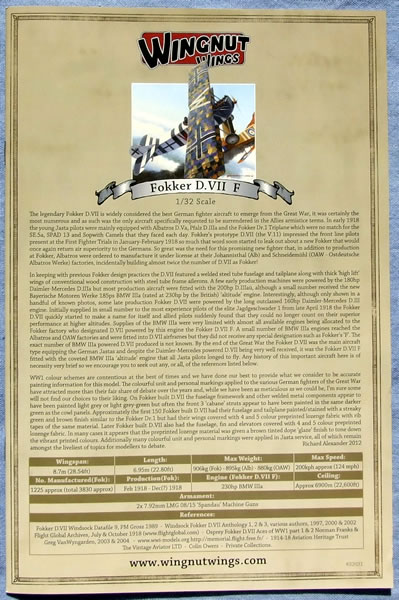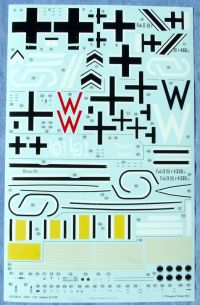Wingnut Wings | #32031: 1/32 Fokker D.VII F
Reviewed by Kevin Futter

New Zealand firm Wingnut Wings has established an enviable reputation for quality kits of hitherto ignored subjects, and has gladdened the hearts of many a World War One aircraft modeller. Recently it managed to pull yet another Fokker D.VII kit out of its hat, this time the D.VII F version. According to Wikipedia's entry on the type, the D.VII F version was powered by the BMW IIIa engine, rather than a variant of the Mercedes D.III engine, its more usual power plant.
This new D.VII F kit is largely based on the company's earlier D.VII (Fok) release, which we examined in an earlier review. Rather than duplicate that information here, I'll focus on what's different about this kit and refer you to Ron's D.VII (Fok) review for an overview of the base kit. This review should be considered an extension of that one.
New Engine
The principal change in this kit is obviously a new engine sprue for the BMW IIIa, which is also mated to a secondary sprue containing the cowl and exhaust parts specific to the D.VII F. The new engine sprue is labelled "E" with a generic description, while the 'attached' sprue of cowl parts is labelled "G" and described as "32031 1/32 Fokker D.VIIF". Curiously, the latter has a copyright date of 2011, which gives credence to the whispers I've heard about a two-year gestation period for new Wingnut Wings kits.

This replaces the equivalent "E" sprue for the Mercedes D.III engine in the base D.VII (Fok) kit. All the other sprues in the kit appear to be identical to those in the D.VII (Fok), and indeed are all labelled with that release's kit number (#32011).
Decals and Markings
The decals are of course also all-new. Previous releases of the Fokker D.VII from Wingnut Wings have featured an extensive decal package, and while this kit's decal package is more limited, there is still three large sheets in the bag. These consist of a single large sheet of aircraft and national markings, plus two slightly-smaller sheets each of 4-colour lozenge decals. The lozenge sheets are in fact common to all the D.VII releases.
The decals themselves are exquisitely printed by Cartograf in Italy, and exhibit perfect registration, finely-printed details and no obvious signs of translucence.
The sheet features markings for five aircraft:
- Fokker D.VII F 460/18, Eric Just, Jasta 11, August 1918 (6 victories)
- Fokker D.VII F 501/18, "Red W", Jasta 26, November 1918
- Fokker D.VII F 4253/18, Ernst Udet, Jasta 4, September 1918 (62 victories)
- Fokker D.VII F 4330/18, Egon Koepsch?, Jasta 4, August 1918 (9 victories)
- Fokker D.VII F, Karl Bolle, Jasta 2, November 1918 (36 victories)
Instruction Booklet
The instruction booklets supplied in Wingnut Wings kits have become legendary, and with good reason. The production values are equivalent to a glossy magazine, and to refer to them as mere instruction booklets does them a grave disservice.

The cover features a potted history of the type, and a specifications table at the bottom. This material is also available on the Wingnut Wings webpage for the kit.
The content features colourful and highly-detailed annotated assembly drawings, complemented by captioned reference photographs and painting instructions. Just be careful when removing it from its plastic bag, as it also houses the kit's photo-etched fret, and a lack of attention here may result in it going missing!

Conclusion
This kit represents everything we've come to expect from Wingnut Wings: exceptional moulding quality, excellent detail, superb decals and industry-leading documentation. What more could you ask for? Highly recommended.
Review sample supplied by Wingnut Wings.
© Kevin Futter 2013
This review was published on Thursday, April 11 2013; Last modified on Wednesday, May 18 2016



